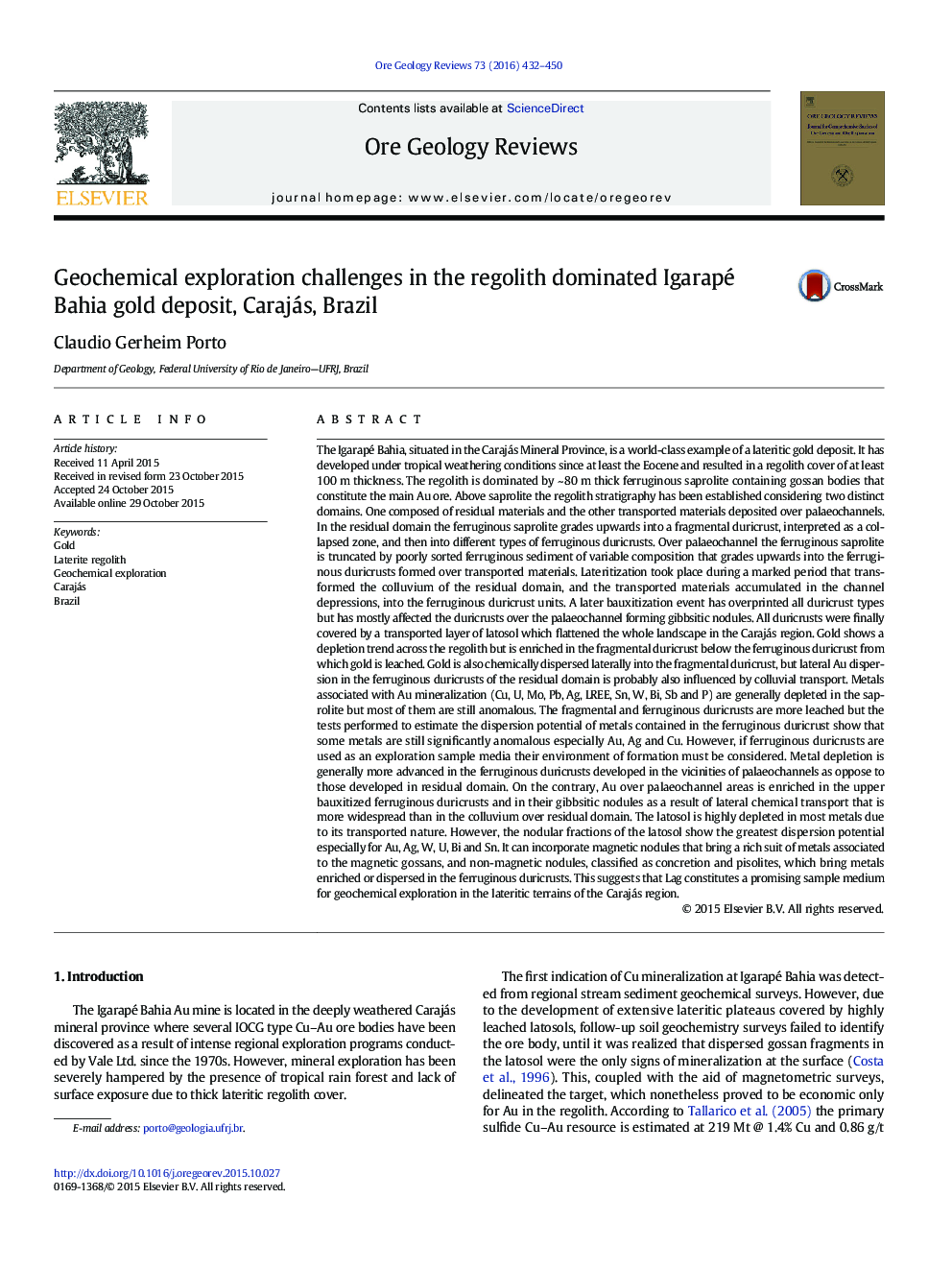| کد مقاله | کد نشریه | سال انتشار | مقاله انگلیسی | نسخه تمام متن |
|---|---|---|---|---|
| 4696935 | 1351857 | 2016 | 19 صفحه PDF | دانلود رایگان |

• Establishment of the regolith stratigraphy of the deposit area.
• Geochemical and mineralogical characterization of the regolith units.
• Comprehensive study of the grade distribution across the regolith profile.
• Investigation of the dispersion processes that takes place across the regolith profile with special reference to gold.
• Investigation of the geochemical exploration sampling media including duricrusts, latosol and lag materials.
• Discussion on the exploration significance for the lateritic terrains of the Carajás mineral province.
The Igarapé Bahia, situated in the Carajás Mineral Province, is a world-class example of a lateritic gold deposit. It has developed under tropical weathering conditions since at least the Eocene and resulted in a regolith cover of at least 100 m thickness. The regolith is dominated by ~ 80 m thick ferruginous saprolite containing gossan bodies that constitute the main Au ore. Above saprolite the regolith stratigraphy has been established considering two distinct domains. One composed of residual materials and the other transported materials deposited over palaeochannels. In the residual domain the ferruginous saprolite grades upwards into a fragmental duricrust, interpreted as a collapsed zone, and then into different types of ferruginous duricrusts. Over palaeochannel the ferruginous saprolite is truncated by poorly sorted ferruginous sediment of variable composition that grades upwards into the ferruginous duricrusts formed over transported materials. Lateritization took place during a marked period that transformed the colluvium of the residual domain, and the transported materials accumulated in the channel depressions, into the ferruginous duricrust units. A later bauxitization event has overprinted all duricrust types but has mostly affected the duricrusts over the palaeochannel forming gibbsitic nodules. All duricrusts were finally covered by a transported layer of latosol which flattened the whole landscape in the Carajás region. Gold shows a depletion trend across the regolith but is enriched in the fragmental duricrust below the ferruginous duricrust from which gold is leached. Gold is also chemically dispersed laterally into the fragmental duricrust, but lateral Au dispersion in the ferruginous duricrusts of the residual domain is probably also influenced by colluvial transport. Metals associated with Au mineralization (Cu, U, Mo, Pb, Ag, LREE, Sn, W, Bi, Sb and P) are generally depleted in the saprolite but most of them are still anomalous. The fragmental and ferruginous duricrusts are more leached but the tests performed to estimate the dispersion potential of metals contained in the ferruginous duricrust show that some metals are still significantly anomalous especially Au, Ag and Cu. However, if ferruginous duricrusts are used as an exploration sample media their environment of formation must be considered. Metal depletion is generally more advanced in the ferruginous duricrusts developed in the vicinities of palaeochannels as oppose to those developed in residual domain. On the contrary, Au over palaeochannel areas is enriched in the upper bauxitized ferruginous duricrusts and in their gibbsitic nodules as a result of lateral chemical transport that is more widespread than in the colluvium over residual domain. The latosol is highly depleted in most metals due to its transported nature. However, the nodular fractions of the latosol show the greatest dispersion potential especially for Au, Ag, W, U, Bi and Sn. It can incorporate magnetic nodules that bring a rich suit of metals associated to the magnetic gossans, and non-magnetic nodules, classified as concretion and pisolites, which bring metals enriched or dispersed in the ferruginous duricrusts. This suggests that Lag constitutes a promising sample medium for geochemical exploration in the lateritic terrains of the Carajás region.
Journal: Ore Geology Reviews - Volume 73, Part 3, March 2016, Pages 432–450